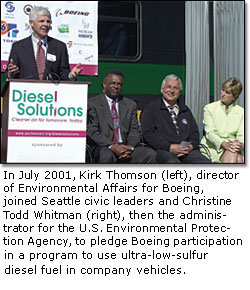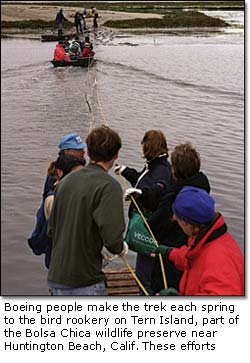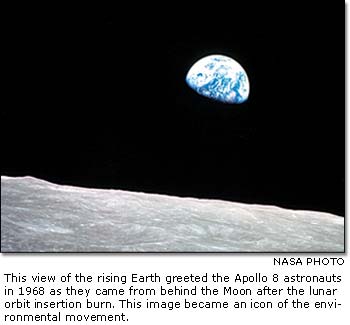One for the big
blue marble
Earth Day takes place this month. Here's
how Boeing has pitched in for the environment
BY KIRK THOMSON

| Green through the years
Here's a timeline showing environmental achievements at Boeing.
1966: Boeing begins work on the 747, the first jetliner to
use second-generation large turbofan engines to dramatically
improve fuel economy and reduce noise and emissions.
1966-72: Delta rockets launch 9 Earth-observation satellites
for the Environmental Sciences Services Administration.
1968: Photo of earth taken by Apollo 8 spacecraft becomes
an icon for environmental progress in the 1970s and 1980s.
1972: Boeing technology is applied to rapid-transit systems,
renewable-energy systems and wastewater purification.
1977: Boeing delivers the second Applications Explorer Mission
satellite, which will map the earth's atmospheric ozone layer
for the first time.
1981: Boeing-built wind generators begin producing power in
eastern Washington State.
1983: 757 and 767 introduce "Stage 3" quiet, fuel-efficient
engines that would become mandatory for all U.S. aircraft in
2000.
1992-93: Two years in a row, Boeing wins the U.S. Environmental
Protection Agency's Stratospheric Ozone Protection Award for
technology developments in finding substitutes for ozone-depleting
chlorofluorocarbons.
1993: Boeing earns the U.S. EPA's 33/50 Performance Award
by cutting toxic chemical use in half in only three years.
1995: Boeing wins the National Recycling Coalition's Corporate
Leadership Award.
1996: Boeing Commercial Airplanes introduces low-solvent topcoat
paint on commercial airplanes, after years of research to find
formulas that would prevent corrosion, meeting FAA requirements
for safety certification.
1999: Landsat 7 is launched aboard a Delta rocket and Boeing
wins the EPA Green Lights Partner of the Year Award.
2000: Boeing employees in Washington state plant more than
20,000 trees as partners in the Mountains To Sound Greenway's
program to plant 200,000 trees in 2000.
2003: Solar-powered car uses Boeing Spectrolab solar cells
to win the American Solar Challenge, and Boeing announces work
on a fuel-cell electric airplane.
2004: Boeing formally launches the 7E7 Dreamliner program
(later designated the 787 Dreamliner), to build a new family
of commercial jetliners that will set a new standard in quiet,
fuel-efficient environmental performance
|
|
As the world prepares to celebrate the 35th anniversary of Earth Day
on April 22, you can expect to see breathtaking photos of the earth,
as seen from space. The 1968 image of the lonely blue planet taken from
Apollo 8, built and launched using technology from Boeing's predecessor
companies, became an icon of the environmental movement, which celebrated
the first Earth Day 16 months after that mission.
In the decades since, Boeing people have been at work tackling numerous
environmental problems, from the local to the global.

Boeing volunteers pitch in on projects taking place on Earth Day, as
well as the rest of the year. In addition, Boeing partners with numerous
nonprofit agencies to support efforts to conserve and protect habitat
and open spaces and to provide support for environmental research and
education.
Boeing researchers and engineers have a long history (see time line
right) of developing technologies that contribute to a more sustainable
life on earth. In the 1970s, Boeing created ways to purify water in regions
where the supply was scarce or unhealthy. Boeing built the first satellite
to map the Earth's ozone layer, an AEM-2 (Applications Explorer Mission)
satellite that carried the SAGE-1 (Stratospheric Aerosol and Gas Experiment)
instrument. The company also pioneered solar, wind and biomass energy
sources.
 Boeing
has earned numerous awards for conservation practices, recycling efforts
and investments in research to develop cleaner and greener products,
production materials, and manufacturing processes. The design of commercial
airplanes demonstrates the company's long-standing commitment. Compared
to 1970, Boeing airplanes now deliver twice the passenger miles for each
gallon of fuel, while also being 78 percent quieter. The 787 Dreamliner
will continue this record of improvement (see story below). Boeing
has earned numerous awards for conservation practices, recycling efforts
and investments in research to develop cleaner and greener products,
production materials, and manufacturing processes. The design of commercial
airplanes demonstrates the company's long-standing commitment. Compared
to 1970, Boeing airplanes now deliver twice the passenger miles for each
gallon of fuel, while also being 78 percent quieter. The 787 Dreamliner
will continue this record of improvement (see story below).
Boeing chemical and materials research has introduced many breakthroughs
to reduce the environmental impact of painting, plating and other manufacturing
processes. The company shares the benefit of these new low-waste materials
and manufacturing techniques with suppliers, customers and even competitors.
Boeing facilities employ sophisticated on-site treatment facilities to
minimize waste through recycling and treatment of their manufacturing-process
water, saving millions of gallons per day.
 Not only do Boeing processes demonstrate care in protecting the natural
environment, but so do its people. They spend each day creating innovative
products and systems that are used to explore the earth from space, connect
cultures through global communication and travel, and thereby foster
international cooperation to protect the earth for future generations.
At the same time, they also take time to help in their own communities
around the year. To them, every day is Earth Day. Not only do Boeing processes demonstrate care in protecting the natural
environment, but so do its people. They spend each day creating innovative
products and systems that are used to explore the earth from space, connect
cultures through global communication and travel, and thereby foster
international cooperation to protect the earth for future generations.
At the same time, they also take time to help in their own communities
around the year. To them, every day is Earth Day.
Kirk Thomson is the director of Environmental Affairs for Boeing.

| 787 Dreamliner: Keeping it clean Boeing's commitment to continually improving the environmental
performance of its commercial airplanes is easy to see. Every new
generation of Boeing jet transports brings a step forward in fuel
efficiency, use of environmentally preferred materials, reduced
emissions and lower community noise.
The Boeing 787 Dreamliner begins the next wave of environmental
improvements. The 787 uses 20 percent less fuel (on a per-passenger
basis) than similarly sized airplanes. This equates to a 20 percent
reduction in carbon dioxide emissions. A common method of assessing
takeoff noise is to measure how much of the airport community is
exposed to a given noise level (typically 85 decibels). The 787
has a 60 percent smaller noise "footprint" than its competition.
"Environmental performance is not just a by-product of the
design. It is a very deliberate effort," said Jeff Hawk, director
of Certification, Government Relations and Environment for the
787 program.
Boeing's 787 program is taking a life cycle approach to ensuring
that the overall environmental impact of the airplane is lower
than previous airplanes. This ranges from the use of environmentally
preferred materials during the manufacturing process to working
with universities around the world to develop the technologies
that will be needed decades from now when the first 787s are ready
to retire.
—Lori Gunter
|
|

